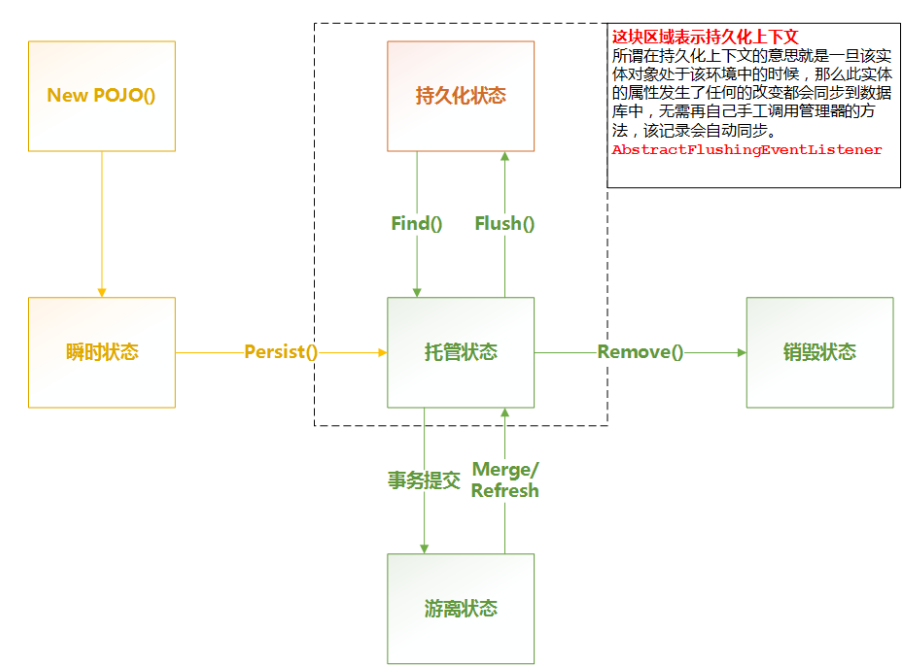Work hard, enjoy life, make history
-
经常用到的各种命令
前言
日常使用的各种命令
mysql 相关命令
-
查看表有哪些索引
SHOW INDEX FROM tbl_name -
检查mysql缓存是否打开
show variables like '%query_cache%';Variable_name Value have_query_cache YES query_cache_limit 1048576 query_cache_min_res_unit 4096 query_cache_size 0 query_cache_type OFF query_cache_wlock_invalidate OFF IDEA 相关命令
1.跳转到某一行
Ctrl + G
2.当前类的方法和变量
Ctrl + F12
3.替换文本
Ctrl + R- 定位class
在左侧project view的scroll from source按钮 - exception breakpoint
5.1 在debugger里面,打开view breakpoints(Ctrl + Shift + F8), 点击左上角绿色+, 选择java exception breakpoints, 输入一个异常类, 然后打钩, 点Done, 这样当发生这个异常的地方就能断点了
-
-
JPA 更新entity
前言
算是对spring jpa对象状态的进一步理解吧
spring jpa version:1.10.1
底层hibernate: 5.1.0场景
从数据库查询出一些任务数据,分发,更改任务状态,执行任务,然后更新任务下次执行时间
遇到的问题
save的时候除了下次执行时间,status字段也被更新了,由于在entity上面使用的dynamic update注解,所以debug看看具体怎么发生的
执行过程
1.一路debug,进入到DefaultMergeEventListener,onMerge(line:64) -> createEntityCopyObserver(line:77) -> onMerge(line:105) 2.在line:144,获取EntityEntry,后续判断,发现对象已经处于游离状态
switch ( entityState ) { case DETACHED: entityIsDetached( event, copyCache ); break; case TRANSIENT: entityIsTransient( event, copyCache ); break; case PERSISTENT: entityIsPersistent( event, copyCache ); break; default: //DELETED throw new ObjectDeletedException( "deleted instance passed to merge", null, getLoggableName( event.getEntityName(), entity ) ); }然后进入到entityIsDetached方法
3.在这个方法里面(依然在DefaultMergeEventListener),line:289,从数据库读了一次,从log也可以看到进行了一次数据库读操作, 到下面的line:326,如下,target是从数据库刚读出来的对象,entity是我们想要进行update的对象,在copyValues的时候,虽然我们只 更新了执行时间,但是这时候2个对象的status值也是不同的,所以target的status被赋予了entity的status值,而这个值是错误的, 所以打印的update sql里面包含了set status=X 的语句
// cascade first, so that all unsaved objects get their // copy created before we actually copy cascadeOnMerge( source, persister, entity, copyCache ); copyValues( persister, entity, target, source, copyCache ); //copyValues works by reflection, so explicitly mark the entity instance dirty markInterceptorDirty( entity, target, persister );总结
对spring jpa中对象的状态变化不够了解啊,数据查出来后,事务提交,则该对象就变成游离状态了

-
JPA join查询使用
前言
使用spring jpa作为orm工具,有一个单向一对多关系,进行查询的问题,不加额外处理会有n+1问题
spring jpa version:1.10.1
底层hibernate: 5.1.0步骤一, 定义自定义的repository
@NoRepositoryBean public interface CustomRepository<T, ID extends Serializable> extends JpaRepository<T, ID>, JpaSpecificationExecutor<T> { Page<T> findAll(Specification<T> spec, Pageable pageable, EntityGraph.EntityGraphType entityGraphType, String entityGraphName); Page<T> findAll(Specification<T> spec, Pageable pageable, String entityGraphName); }主要是使用EntityGraph
步骤二, 实现上面的repository
public class CustomRepositoryImpl<T, ID extends Serializable> extends SimpleJpaRepository<T, ID> implements CustomRepository<T, ID> { private EntityManager em; public CustomRepositoryImpl(JpaEntityInformation entityInformation, EntityManager entityManager) { super(entityInformation, entityManager); this.em = entityManager; } @Override public Page<T> findAll(Specification<T> spec, Pageable pageable, EntityGraph.EntityGraphType entityGraphType, String entityGraphName) { TypedQuery<T> query = getQuery(spec, pageable.getSort()); query.setHint(entityGraphType.getKey(), em.getEntityGraph(entityGraphName)); return readPage(query, pageable, spec); } @Override public Page<T> findAll(Specification<T> spec, Pageable pageable, String entityGraphName) { return findAll(spec, pageable, EntityGraph.EntityGraphType.FETCH, entityGraphName); } }上面的实现类和其他正常的repository放在不同的package
entity的代码,添加EntityGraph
@Table(name = "XX_YY") @NamedEntityGraphs({ @NamedEntityGraph( name = "xxyyWithZZ", attributeNodes = { //跟下面的属性同名 @NamedAttributeNode("imgList") } ) }) public class XXYYEntity implements Serializable { private static final long serialVersionUID = -3476018376851461504L; @Id @GeneratedValue(strategy = GenerationType.IDENTITY) @Column(name = "id") private long id; @Column(name = "name", length = 45) private String name; @Column(name = "desc", length = 45) private String desc; @OneToMany(fetch = FetchType.EAGER, cascade = CascadeType.ALL) @JoinColumn(name = "zz_id") @Where(clause = "is_valid=1") //这个条件是加在XXYYZZ表的where条件里面的 private List<XXYYZZ> imgList; }XXYY表的id和XXYYZZ的zz_id进行join关联
步骤三, 配置
<jpa:repositories base-package="xxx.yyy.repository" base-class="xxx.zzz.CustomRepositoryImpl" transaction-manager-ref="transactionManager" entity-manager-factory-ref="entityManagerFactory" />如何使用
定义一个repository,继续最开始的自定义repository接口,然后在service里面组装好Specification,Pageable,并指定entigyGraph名称 进行调用
Page<XXYYEntity> content = xxyyRepository.findAll(spec, pageable, "xxyyWithZZ");问题
1.若一个entity包括多个一对多关系,则需要把list换成set,否则报错,或者显示指定@IndexColumn 2.不使用上面的方式,直接定义一个repository,然后使用@EntityGraph注解
XXYYRepository extends JpaRepository<XXYYEntity, Long>, JpaSpecificationExecutor<XXYYEntity> { @EntityGraph("xxyyWithZZ") List<XXYYEntity> getByIsValid(int valid); }假设xxyy有4条记录,前两条记录分别有2条XXYYZZ,则上述查询会返回6条记录,如下
1-{2条xxyyzz}
1-{2条xxyyzz}
2-{2条xxyyzz}
2-{2条xxyyzz}
3-
4-
后期可以看看为什么这么返回以及如何处理参考
http://docs.spring.io/spring-data/jpa/docs/current/reference/html/#jpa.query-methods.at-query http://docs.spring.io/spring-data/jpa/docs/current/reference/html/#repositories.single-repository-behaviour
-
spring aop笔记
前言
这个用的少, 总是忘, 还是记录一下吧.
拦截自定义注解, 执行方法
自定义注解
@Target({ElementType.METHOD}) @Retention(RetentionPolicy.RUNTIME) public @interface MethodCostTag { String methodName() default ""; }拦截器, 注解了上面注解的方法会被拦截, 打印一下方法执行时间
@Slf4j @Aspect @Component public class MethodCostAop { @Around(value = "@annotation(methodCostTag)") public Object aroundMethod(ProceedingJoinPoint proceedingJoinPoint, MethodCostTag methodCostTag) throws Throwable{ String methodName = methodCostTag.methodName(); long t1 = System.currentTimeMillis(); Object obj = proceedingJoinPoint.proceed(proceedingJoinPoint.getArgs()); log.info("method execution cost:method is :{}, cost is :{}", methodName, (System.currentTimeMillis() - t1)); return obj; } }拦截自定义注解, 拦截类里的方法
定义一个注解
@Target({ElementType.TYPE}) @Retention(RetentionPolicy.RUNTIME) public @interface ClassMethodTag { }定义拦截方法, 需要使用@within, 则标注了注解的类里的方法都会被拦截
@Before(value = "@within(classMethod)") public void beforeMethod(JoinPoint joinPoint, ClassMethodTag classMethod) throws Throwable{ System.out.println("afasfadasdfsdadfadfdsfaf====" + System.currentTimeMillis()); }直接使用controllerAdvice
controller方法签名, 标注一下@Valid注解, 对象的熟悉需要标注校验注解(@NotNull和其他)
@PostMapping("/routeAgreement") public RouterAgreementRes routeAgreement(@Valid @RequestBody RouterAgreement agreement) throws BusinessException { }拦截逻辑, 参数校验不通过直接返回特定的错误码
/** * 对controller的参数对象进行统一校验,出现异常后的统一返回错误信息 */ @Slf4j @RestControllerAdvice public class ParamValidationControllerAdvice { @ExceptionHandler(MethodArgumentNotValidException.class) public BaseRes validExceptionHandler(MethodArgumentNotValidException e) { log.info("validate controller param fail:{}", e.getMessage()); BaseRes res = new BaseRes(); res.setRespCode(ErrorCodeEnum.AgreementParameterNotMatch.getCode()); res.setRespMsg(ErrorCodeEnum.AgreementParameterNotMatch.getDesc()); return res; } }
-
resteasy调用流程
前言
用resteasy调用其他系统的服务,配置的http pool,为了检验一下何时释放的链接,debug了一下,对调用链路做个笔记
resteasy version:3.0.19.Final调用链路
-
执行前
ClientProxy
-> ClientInvoker
-> ClientRequest
-> ClientExecutionContextImpl
-> ApacheHttpClient4Executor
-> CloseableHttpClient
-> InternalHttpClient.doExecute - 然后return
- 直到返回到ClientInvoker -> BodyEntityExtractor
解释说明
1.在ApacheHttpClient4Executor, 创建了释放链接和从stream中获取对象的类
2.BodyEntityExtractor, 这里检测http status是否异常,异常则抛异常,且返回异常的对象的时候,做了一个copy stream的动作, 这样保证释放了当前的链接, 又保留了原始的数据流, 这样如果客户端想要进行自定义的一些操作,依然可以读到数据
-